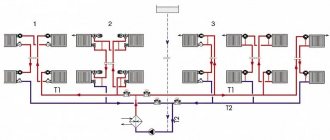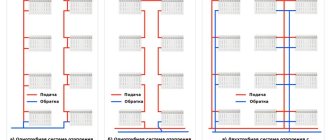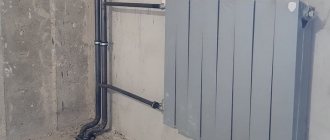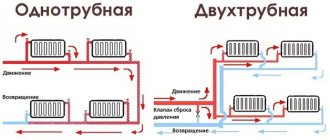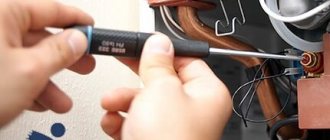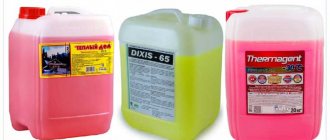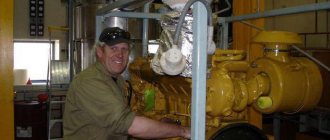What is the maintenance and repair of heating systems? Who can and should do these jobs? What do repair instructions look like, for example, for valves in an elevator unit? Let's try to answer these questions.
Let's start with a small disclaimer.
This article presents purely the practical experience of a former plumber with many years of experience. It is possible that constantly changing legislation and standards now require that repair work be carried out differently; however, this is exactly what happens in the real world.
So let's get started.
We will try to find out who solves problems of this kind and how.
Types of heating systems for apartment buildings
Depending on the structure, characteristics of the coolant and piping layouts, heating of an apartment building is divided into the following types:
By location of the heat source
- Apartment heating system, in which a gas boiler is installed in the kitchen or separate room. Some inconveniences and investments in equipment are more than compensated by the ability to turn on and regulate heating at your discretion, as well as low operating costs due to the absence of losses in heating mains. If you have your own boiler, there are practically no restrictions on system reconstruction. If, for example, the owners want to replace the batteries with warm water floors, there are no technical obstacles to this.
- Individual heating, in which one house or residential complex has its own boiler room. Such solutions are found both in the old housing stock (stokers) and in new luxury housing, where the community of residents decides for itself when to start the heating season.
- Central heating in an apartment building is most common in typical housing.
The installation of central heating in an apartment building, heat transfer from the thermal power plant is carried out through a local heating station.
According to coolant characteristics
- Water heating uses water as a coolant. In modern housing with apartment or individual heating, there are economical low-temperature (low-potential) systems where the coolant temperature does not exceed 65 ºС. But in most cases and in all typical houses, the coolant has a design temperature in the range of 85-105 ºС.
- Steam heating of an apartment in an apartment building (water vapor circulates in the system) has a number of significant disadvantages; it has not been used in new buildings for a long time; old housing stock is being transferred to water systems everywhere.
According to the wiring diagram
Basic heating schemes in apartment buildings:
- Single-pipe - both the supply and return of coolant to the heating devices are carried out through one line. Such a system is found in “Stalin” and “Khrushchev” buildings. It has a serious drawback: the radiators are located in series and, due to the cooling of the coolant in them, the heating temperature of the batteries drops as they move away from the heating station. In order to maintain heat transfer, the number of sections increases as the coolant moves. In a pure one-pipe circuit, it is impossible to install control devices. It is not recommended to change the configuration of the pipes or install radiators of a different type and size, otherwise the operation of the system may be seriously disrupted.
- “Leningradka” is an improved version of a single-pipe system, which, thanks to the connection of heating devices via a bypass, reduces their mutual influence. You can install regulating (not automatic) devices on radiators, or replace the radiator with a different type, but of similar capacity and power.
On the left is a standard one-pipe system to which we do not recommend making any changes. On the right is the Leningradka, it is possible to install manual control valves and correctly replace the radiator
The two-pipe heating scheme for an apartment building became widely used in Brezhnevkas and is still popular to this day. The supply and return lines are separated, so the coolant at the entrances to all apartments and radiators has almost the same temperature; replacing radiators with a different type and even volume does not have a significant effect on the operation of other devices. Control devices, including automatic ones, can be installed on batteries.
On the left is an improved version of the single-pipe circuit (analogous to the Leningrad circuit), on the right is the two-pipe version. The latter provides more comfortable conditions, precise regulation and gives greater opportunities for replacing the radiator
The beam scheme is used in modern atypical housing. The devices are connected in parallel, their mutual influence is minimal. The wiring is usually done in the floor, which allows you to free the walls from pipes. When installing control devices, including automatic ones, accurate dosing of the amount of heat throughout the rooms is ensured. It is technically possible to either partially or completely replace the heating system in an apartment building with a radial circuit within the apartment with a significant change in its configuration.
With a radial scheme, the supply and return lines enter the apartment, and the wiring is carried out in parallel with separate circuits through the collector. Pipes are usually placed in the floor, radiators are neatly and discreetly connected from below
First steps in the event of an emergency
How to wrap a heating pipe? If you have a couple of clamps with rubber seals in stock at home, you can prevent some emergency situations. In the event of an accident, the most important thing to do is to shut off the coolant supply to the area where the heating pipe is leaking.
Covering the heating riser of a multi-storey building
You will need to stop the heating boiler, turn off the pump and turn off the necessary taps and valves. The clamp will solve the problem temporarily, so repairs will still be inevitable. Before you begin the repair, you will need to prepare the necessary materials and tools, turn off the heating, turn off all taps and drain the water from the system. Depending on the material from which the pipes are made, repairs can be carried out in various ways.
Types of system maintenance work
According to Appendix 1 to the Methodological Manual for the Maintenance and Repair of Housing Stock MDK 2-04.2004, maintenance of communications, technical devices and premises consists of the following list of works:
- conservation and re-preservation;
- adjustment of taps, valves, gate valves;
- adjustment and packing of oil seals;
- compaction of squeegees;
- system check;
- descaling;
- turning off radiators in case of leakage;
- washing and cleaning of constituent components;
- draining/filling the system with water;
- eliminating air jams;
- strengthening pipelines.
If an accident is detected, the damaged fittings are repaired and replaced.
Who is to blame for the system malfunction?
All accidents associated with the heating system can be divided into intra-apartment and intra-house. This separation allows you to determine who is to blame for the problems.
Legally, responsibility for the heating system rests with consumers of services and the companies that provide them. The management company is fully responsible for the in-house system, so the blame for the accident falls on this organization.
Limits of responsibility between owners and management companies
Owners of housing in apartment buildings must ensure the safety of not only their apartment, but also common property. By signing the contract, each tenant agrees to these conditions of living in the apartment building.
And yet, many people believe that since the batteries are in their apartment, they belong to them by right of ownership. However, the heating system along with the radiators is included in the structure of the common property of the house. Therefore, only management companies are involved in their repair and replacement.
What sets our company apart from others
There are several reasons that make people turn to us:
- extensive experience of our craftsmen - we can perform all plumbing work without exception;
- commitment - having taken on a job, we bring it to the end;
- responsibility – we are responsible for the quality of our work;
- reasonable prices - we do not inflate prices so that our services are accessible to everyone;
- efficiency – we do our work not only efficiently, but also quickly;
- politeness – our dispatchers respect their clients, they will politely and thoroughly answer all your questions asked by phone;
- preliminary agreement – you can agree with us in advance about any plumbing work in your home, our specialists will carry it out at a time convenient for you.
By choosing our company, you can be sure that all work will be completed with high quality and on time.
Types of radiators for heating apartment buildings
In multi-storey buildings there is no single rule allowing the use of a specific type of radiator, so the choice is not particularly limited. The heating scheme of a multi-storey building is quite universal and has a good balance between temperature and pressure.
The main models of radiators used in apartments include the following devices:
- Cast iron batteries
. Often used even in the most modern buildings. They are cheap and very easy to install: as a rule, apartment owners install this type of radiators themselves. - Steel heaters
. This option is a logical continuation of the development of new heating devices. Being more modern, steel heating panels demonstrate good aesthetic qualities, are quite reliable and practical. They combine very well with the control elements of the heating system. Experts agree that steel batteries can be called optimal for use in apartments. - Aluminum and bimetallic batteries
. Products made from aluminum are highly valued by owners of private houses and apartments. Aluminum batteries have the best performance when compared with previous options: excellent appearance, light weight and compactness are perfectly combined with high performance characteristics. The only disadvantage of these devices, which often scares off buyers, is the high cost. However, experts do not recommend saving on heating and believe that such an investment will pay off quite quickly.
Conclusion
The correct choice of batteries for a centralized heating system depends on the performance indicators that are inherent in the coolant in the given area. Knowing the cooling rate of the coolant and its movement, you can calculate the required number of radiator sections, its dimensions and material. We should not forget that when replacing heating devices, it is necessary to ensure that all rules are followed, since their violation can lead to defects in the system, and then the heating in the wall of a panel house will not perform its functions (read: “Heating pipes in the wall ").
It is also not recommended to carry out repair work in the heating system of an apartment building on your own, especially if it is heating within the walls of a panel house: practice shows that residents of houses, without the appropriate knowledge, are able to throw away an important element of the system, considering it unnecessary. Centralized heating systems demonstrate good qualities, but they need to be constantly maintained in working order, and for this you need to monitor many indicators, including thermal insulation, wear and tear of equipment and regular replacement of worn-out elements.
Installation and replacement of heating, water supply and sewerage pipes
The SantekhKomplekt company offers its services for the replacement (installation) of all types of pipes. In our company, you can independently choose the material from which installation, installation, and replacement of pipes will be carried out. be it a riser for cold and hot water supply, installation of pipes for a heating system or sewerage system. When performing pipe replacement work, we use only high-quality materials.
Types of installation (replacement) of heating and water supply pipes
- Installation of metal-plastic pipes
- Installation of polypropylene pipes
- Installation of copper pipes
- Installation of steel pipes
- Installation of various plastic and polymer pipes
Installation of metal-plastic pipes
This type of pipe is used for internal (inside walls and screed) and external distribution of water supply and heating pipes. These pipes are inexpensive, easy to use and easy to bend.
Installation of polypropylene pipes
Polypropylene is used for external plumbing and heating; they are also not difficult to work with and are more aesthetically pleasing. When installing pipes in cottages, polypropylene pipes are most often used. 85-90% of cottage owners choose them. When installing heating, pipes made of reinforced polypropylene are used.
Installation of copper pipes
Installation of copper pipes is carried out when laying heating and water supply pipes, mainly in apartments and country houses. Despite the higher cost, copper pipes are very popular due to their high technical characteristics and durability (the service life of copper pipes is more than 50 years).
Let's consider this example: you don't want to change the radiator, but the pipe going to the neighbors from above has already served its purpose, and the section from the ceiling to the radiator needs to be replaced. Find out if there is water in the system, and be sure to ask your neighbors above and below if they have replaced the radiators, is the original pipe still in place, or is it polypropylene? It is necessary to find out if heating radiators are installed in a new way. and connected with polypropylene transition couplings, then when you cut the pipe and start threading, the pipe in the ceiling may turn, and you will also redo it for your neighbor.
1 example. The neighbor above has radiators lined with polypropylene. You also need to run the riser with the same pipes (for heating, use only “shtabi” pipes) and the same diameter. We cut off the iron pipe, cut off the transition coupling, pull the pipe out of the ceiling, insert a polypropylene pipe into the ceiling, and solder to the neighbor through the polypropylene coupling,
the same as when replacing water pipes. Don't forget to remove the foil layer with a special stripper on the stacked pipe (soldering polypropylene pipes). If your radiators are connected without a jumper, then it’s easier, unscrew the rest of the pipe from the radiator, screw in a faucet with an American connection, screw the adapter into the faucet and solder it to the riser. If the radiator is of the chord type, then cut a thread on the pipe, screw in the tap, screw the adapter onto the American one, and solder it to the heating riser in the same way. If the connection to the battery is with a jumper, then do the same as when installing a radiator (correct installation of heating radiators).
When replacing old heating systems, more and more people are choosing polypropylene products.
Polypropylene pipes are especially distinguished by their ease of installation combined with sufficient practicality of the products.
Polypropylene has a number of advantages over metal:
- corrosion resistance;
- high strength, while it is several times lighter than metal;
- the inner surface of the pipes is protected from the formation of lime deposits;
- the material is heat-saving;
- does not affect the chemical composition of water;
- absence of water noise as it passes through the pipes;
- long service life without the need for repairs;
- aesthetic appearance;
- relative ease of installation.
Repair time
One of the most important aspects of the sanitary well-being of the population is the hours of repair. This issue is the prerogative of regional legislation. Subjects of the federation have the right to independently decide:
- what hours can repairs or construction work be carried out;
- at what time period during the day should silence be observed;
- on what days work can be carried out, and when this will be considered a violation;
- how long can repairs in a high-rise residential building take, and in what cases additional permission will be required.
Let's look at examples typical for some regions.
Rules in force in Moscow and Moscow Region
For Muscovites, the time when repairs can be made in an apartment building is established by clause 1.1 of Art. 2 of Moscow Law No. 42. The legislator clearly defined that the time frame within which noisy repair work is permissible covers the period from 9 a.m. to 7 p.m.
This mode is valid from Monday to Saturday. On Sundays, other weekends and holidays, noisy work is prohibited.
Such requirements have only been in effect since 2016. Before the amendments were made to the law, only the time when it was prohibited to make repairs in an apartment building according to the law was regulated. Previously, this was the period from 23 pm to 7 am.
The Moscow Region has different rules for observing quiet times. It must be saved:
- from 21:00 to 8:00 on weekdays;
- from 22 to 10 am on weekends and holidays.
At the same time, regardless of the day of the week, there is a mandatory quiet hour from 13 to 15.
Rules in force in the regions
Although the regions of Russia have adopted different legal acts, they are not much different from the capital. They are based on general principles, in particular:
- prohibition or restrictions on noisy work on weekends/holidays;
- establishing a time frame within which repair or construction work is permissible during the day, or a period when noisy work is prohibited (in the evening, morning and night), introducing a daytime quiet regime;
- determination of the maximum daily duration and timing of repairs.
The generally accepted rules that apply in all regions also include the inadmissibility of the following actions:
- redevelopment without appropriate permission;
- placement of construction waste in premises that are common property of residents of a high-rise building;
- littering of emergency exits and so on.
Installation - heating, water supply, sewerage turnkey.
In a country house, installation of water supply and sewerage begins with the preparation of the project. It takes into account the location of each tap, washbasin and toilet. You will have to calculate the amount of insulation for sewer pipes and other nuances. If the system is installed in an apartment, you must first remove elements of old communications.
We will carry out installation of heating and water supply on a turnkey basis and with a quality guarantee. Our teams work in Moscow and the region, offering affordable prices. When we finish installing or repairing utility networks, the room will remain clean and all parts of the system will be neatly assembled.
It is better to start installing sewerage, heating and water supply during the construction of a country house or major renovation of an apartment. But we also work on finished objects. After drawing up the project, the employee will prepare an estimate, purchase the necessary materials and send a team to you to carry out the work. And the result will definitely please you.
Repair work by stages
The repair of heating batteries consists of several stages:
- Removing old batteries and replacing them. At this stage, the batteries are removed, heating radiators are repaired, the inside of pipes and heating devices are washed, and if necessary, components can be replaced. If the owner does not want to make a replacement, then it is necessary to do the internal flushing of the heating radiators with your own hands.
If the structure has a large area, then washing is carried out separately for each branch, following the following sequence:
- work related to washing heating appliances;
- pipes supplying water to the system;
- pipes leading water from the system to the heaters.
The easiest way to wash heat supply devices in a room is using soda ash (soda ash or caustic). To carry out such work, radiators must be removed from their fasteners.
On one side, a plug is placed on the hole. On the other hand, a pre-prepared water-soda solution is poured in and a plug is also installed. The heating device is left alone for about an hour and a half. After this, the solution is drained from the heating device and washed with water.
Sometimes, car radiator fluid is used to flush the heat supply system. But in this case, the liquid is left for only 15 minutes, then you need to thoroughly rinse the radiators.
To avoid such contamination and achieve full efficiency from the heating system, you must:
- flush the system as often as possible;
- the water must be of high quality - which will reduce rinsing and extend the service life of the equipment.
Extraneous noise
Sometimes noise may occur in the heating pipes - it can be either a knocking in the heating pipes, or various clicks, and a hum. Why are heating pipes noisy? There are several reasons:
- During operation, the diameter decreases.
- Pipes are leaking.
- A smaller pipe diameter was installed.
You may need to think about how to fix a leaking heating pipe. When you eliminate the leak, you will also eliminate the problem of noisy heating pipes.
Why are the heating pipes still humming? This may be a reduction in pipe diameter. You can hear the heating pipes knocking right on the spot. You need to walk along the pipes and find the reason why the heating pipes are clicking. Usually the source from which the heating pipes click is located in the basement - because there is more pressure here
It is very important to find in time the reason why the heating pipes are shooting, humming or making noise - because this could be a prerequisite for a serious problem
Single pipe heating system
Single-pipe heat supply to an apartment building has a lot of disadvantages, the main one being significant heat losses during the transportation of hot water. In this circuit, the coolant is supplied from the bottom up, after which it enters the batteries, gives off heat and returns back to the same pipe. Hot water first reaches the end consumers living on the upper floors in a barely warm state.
Another disadvantage of such heat supply is the impossibility of replacing the radiator during the heating season without draining the water from the entire system. In such cases, it is necessary to install jumpers, which makes it possible to disconnect the battery and direct the coolant through them.
Thus, on the one hand, as a result of installing a single-pipe heating system circuit, savings are obtained, but on the other hand, serious problems arise regarding the distribution of heat throughout the apartments. Residents freeze in them in winter.
What is washer system
It often happens that in a house located next to a boiler room, the radiators become so hot that residents are forced to open windows, and residents of distant buildings freeze. To avoid this, technicians take measures to distribute heat evenly between consumers.
Washing the heating system of an apartment building is the process of installing special washers with holes of the required caliber on the branches of heating networks. Thanks to this, nearby buildings receive less heat, part of which is sent to distant apartment buildings.
Using such a system allows you to reduce:
- carrier flow through pipes;
- number of boilers used;
- consumption of electricity and fuel.
At the same time, the costs of this procedure are low.
Requirements and standards for heating an apartment
A comfortable temperature for the life of each person is determined by a number of factors. Too high, as well as too low a temperature, negatively affects the condition of the human body. Therefore, the temperature at which the body does not turn on its cooling and heating mechanisms is considered normal. These factors include:
- intensity of human activity;
- season;
- daily temperature fluctuations.
People who work in hot shops or athletes who train will not freeze even at low indoor temperatures. While office workers need warmer conditions.
Also, each person’s body adapts to general climatic conditions. Therefore, for a comfortable existence in winter, it is enough to heat the room to +19...+22°C, and in summer - to +22...+25°C.
According to the rules and regulations, in residential premises the minimum temperature threshold should not fall below +18°C. Heating standards for apartments are easier to develop than for work areas, because the activity of people at home is lower than in production. The permissible temperature fluctuations for each room are different:
- kitchen: the optimal temperature is considered to be +19...+21°C, and acceptable - from +18...+26°C;
- toilet: +19…+21°С; +18…+26°С;
- bathroom: +19…+21°С; +18…+24°С;
- corridor: +18…+20°С; +16…+24°С;
- pantry: +16…+18°С; +12…+18°С.
It has been proven that during sleep the body does not need an additional source of heating, therefore, according to GOST, it is allowed to lower the temperature in residential premises by 3°C from 0 to 5 am.
Using glue
Holes of small and medium sizes, cracks can be sealed. This option is temporary and is only suitable so as not to drain water from the riser or deprive the room of a heat source. After the heating season, the aluminum radiator must be removed in order to carry out high-quality repairs.
You can seal the hole using:
- Epoxy glue.
- Cement.
- A solution called “cold welding”.
Repairing holes with epoxy glue
To use epoxy resin glue, you need to prepare fiberglass or thick fabric. Since any of these materials must be wrapped around the radiator, the use of such adhesive is limited. After all, not every place can be wrapped easily and tightly. For some versions of aluminum radiators, this method is not suitable at all.
To seal holes or cracks:
- Cut the fabric into long narrow strips.
- Clean the area from which water is flowing. That is, remove all paint that has peeled off and all particles that are easily removed. This is done with a spatula. Next, take a brush with metal bristles and clean the surface. There should be pure metal left. It happens that a crack appears in a place where it is impossible to reach with a brush. An iron cable can help in this situation. It is pushed through the desired part of the radiator and pulled by the ends one by one, cleaning the desired area. This area is then dried.
- Apply glue to the treated area and wrap it with cloth.
- Apply glue to the fabric and wind another turn. This should be done until there are 4-5 turns. No glue is applied to the top layer of fabric.
- Secure the fiberglass using clamps or wire.
- Wait for the glue to dry. It dries from 2 hours to 3 days. If the room temperature is 20-25 °C, then it will dry in 2-3 hours.
To enhance the properties of the glue, you can add aluminum or bronze powder to it. Such powder is obtained by grinding off an unnecessary aluminum or bronze part with a rasp. Before use, the glue and powder must be mixed well.
Cracks are repaired in the same way using cement. However, medical bandages should be used instead of cloth. They need to be soaked in the solution and wound around the radiator.
We use “cold welding”
It is very convenient for sealing cracks and holes. This is a putty that looks like plasticine. There are two types:
- Single color.
- Two-color.
The first type is easier to work with, since you need to cut off the desired piece and knead it with your hands. You should wear gloves on your hands, because the putty is chemically active and can harm the skin.
Two-color cold welding must be mixed until a homogeneous solution appears. It becomes sticky while mixing.
The fight against holes using “cold welding” is carried out as follows:
- Clean the damaged area from dirt and paint.
- Knead the cut piece of “cold welding”.
- Apply the solution to the hole and rub it in (this is done with a metal spatula). To prevent the putty from remaining on the spatula, it must be moistened with water.
- If after grouting the cork begins to come out (a bubble forms, which then bursts), it must be rubbed again with a spatula. This may have to be done before the “cold weld” has completely dried. It dries in 5 minutes.
- Secure the plug with a clamp or rubber.
You can also seal the hole with heat-resistant sealant. However, you need to use the right sealant because there are acidic sealants that can corrode aluminum. Practitioners advise using neutral solutions.
Replacing batteries via UC
At the time of an accident (for example, a radiator has leaked), replacing the heating battery lies entirely within the responsibility of the organization, to whose account residents transfer money for maintaining common property and carrying out major repairs. It cannot be said that such a replacement occurs free of charge. Cases of coercion to purchase new devices are not uncommon. It happens that receipts are issued for the cost of work performed.
IMPORTANT! Residents of apartment buildings, regardless of the type of property, do not have to pay anything additional for emergency work. The most unpleasant thing is if the battery replacement process is needed in emergency mode during the heating season. And representatives of the management company will begin to evade their obligations, citing the fact that they have neither time, nor workers, or even radiators themselves
They will remove the old one, install plugs and politely ask you to wait. Moreover, there is no statutory deadline for replacing faulty radiators. In such a situation, it is important to eliminate the cause of the accident. Therefore, in order not to wait for anything, you need to act
And representatives of the management company will begin to evade their obligations, citing the fact that they have neither time, nor workers, or even the radiators themselves. They will remove the old one, install plugs and politely ask you to wait. Moreover, there is no statutory deadline for replacing faulty radiators.
In such a situation, it is important to eliminate the cause of the accident. Therefore, in order not to wait for anything, you need to act
The most unpleasant thing is if the battery replacement process is needed in emergency mode during the heating season. And representatives of the management company will begin to evade their obligations, citing the fact that they have neither time, nor workers, or even the radiators themselves. They will remove the old one, install plugs and politely ask you to wait. Moreover, there is no statutory deadline for replacing faulty radiators.
Actions are recorded in writing. All complaints, statements, acts, any other documents accompanying the process must be in 2 copies. First, a contractor is called to draw up a report. Further, the claim, together with the act, is referred to the Criminal Code. The claim must refer to 491 Decree of the Government of the Russian Federation. The 2nd copy must contain the date and signature of the management company employee who accepted the application. This may also take some time. In case of refusal, the Housing Inspectorate, when contacting them, will take control of the situation and the issue will be resolved. We previously wrote about who to complain to about the management company.
How to request ahead of time?
According to the regulations, major repairs of a building's engineering systems, for example, major repairs of a pipeline, can be carried out ahead of schedule only if a real threat to the life and health of the residents of a particular building is proven.
To make this possible, changes need to be made to the regional program, i.e. local government bodies, management organizations or homeowners' associations must submit an application to the relevant executive authority that deals with this issue.
Naturally, the decision to carry out major repairs earlier will be made only after a series of inspections and examinations of the condition of the building.
It is worth noting that to request repair of engineering systems you need to write a statement. It is designed in a free style according to the generally accepted pattern.
When starting to write an application, you should start by drawing up a header, which states to whom the application is being sent (position, company name), followed by the surname, first name and patronymic of the manager, the applicant’s initials, address and contact telephone number).
The body of the application states the essence of the problem (for example, a major overhaul of heating networks is required), indicates when the last inspection was carried out, and adds descriptions of the condition of engineering systems. This is followed by the date and signature of the applicant.
As a rule, you have to wait 10 working days for a response from the management company, which is REU, ZhEK or REMP.
Carrying out current repairs of an apartment building
D»Â õúÃÂÃÂõóþ ÃÂõüþýÃÂð ò üýþóþúàThe ýðûøÃÂøõ ýõÃÂúþûÃÂúøàÃÂÃÂðÿ þò òÃÂÿþûýõýýÃÂàÃÂðñþÃÂ:
- ÃÂÃÂüþÃÂàúþüøÃÂÃÂøõù ÃÂõÃÂýøÃÂõÃÂà ºÃ¾Ã³Ã¾ ÃÂþÃÂÃÂþÃÂýøàÃÂÃÂÃÂ.
- áþÃÂÃÂðòûõýøõ ÿûðýð üõÃÂþÿÃÂà ¸ÃÂÃÂøù ø þÃÂõÃÂõôýþÃÂÃÂø øàÃÂÂÃÂÃÂÃÂÃ°à ½ÃµÃ½Ã¸ÃÂ.
- ÃÂÃÂþòõôõýøõ ÃÂõýôõÃÂð ø þÿÃÂàµÃ´ÃµÃ»ÃµÃ½Ã¸Ãµ ÿþôÃÂÃÂôýþù þÃÂóðýù ¸Ã·Ã°ÃÂøø ôûàÿÃÂþòõôõýø àüõÃÂþÿÃÂøÃÂÃÂøù ÿþ òþÃÂÃÂÃÂðýþà²Ã»ÃµÃ½Ã¸Ã ÃÂðñþÃÂþÃÂÿþÃÂþñýþÃÂÃÂø øà úþüüÃÂýøúðÃÂøù øà»Ã¸ úþýÃÂÃÂÃÂÃÂúÃÂøòýÃÂàÃÂà»ÃµÃ¼ÃµÃ½ÃÂþò ÃÂÃÂÃÂþõýøÃÂ.
- ÃÂðúûÃÂÃÂõýøõ ôþóþòþÃÂð, ò úþàThe ýõýøàÃÂðñþÃÂ, ÃÂÃÂÃÂðÃÂýÃÂõ ÃÂðýúÃÂà¸Ã¸ ø ÃÂÿþÃÂþñàÃÂÃÂõóÃÂûø ÃÂþòðýøàÃÂÿþÃÂýÃÂàüþüõýÃÂþò.
- ÃÂÃÂÿþûýõýøõ ÃÂõüþýÃÂýÃÂàÃÂðñþ àÃÂøûðüø ÿþôÃÂÃÂôýþù þÃÂÃ³Ã°Ã½Ã¸à ·Ã°ÃÂøø.
- ÃÂÃÂøõüúð ÃÂðñþààÿÃÂøòûõÃÂõýø õü úþüøÃÂÃÂøø, ò úþÃÂþÃÂÃÂàòÃÂþôà VALUE µÃ¹ úþüÿà°Ã½Ã¸Ã¸, ÃÂðú ø ÿÃÂõôÃÂÃÂðòøÃÂõûø ÃÂþ ñÃÂÃÂòõýýøúþò. àÃÂÿþÃÂýÃÂàÃÂøÃÂÃÂðÃÂøÃÂàòþ÷üþöý þ òúûÃÂÃÂõýøõ ò ÃÂþÃÂÃÂðò úþüøÃÂà VALUE óþ ÃÂúÃÂÿõÃÂÃÂð.
- áþÃÂÃÂðòûõýøõ ø ÿþôÿøÃÂàðúàð þ òÃÂÿþûýõýøø ÃÂðñþÃÂ.
Who is to blame for the system malfunction?
All accidents associated with the heating system can be divided into intra-apartment and intra-house. This separation allows you to determine who is to blame for the problems.
Legally, responsibility for the heating system rests with consumers of services and the companies that provide them. The management company is fully responsible for the in-house system, so the blame for the accident falls on this organization.
Limits of responsibility between owners and management companies
Owners of housing in apartment buildings must ensure the safety of not only their apartment, but also common property. By signing the contract, each tenant agrees to these conditions of living in the apartment building.
And yet, many people believe that since the batteries are in their apartment, they belong to them by right of ownership. However, the heating system along with the radiators is included in the structure of the common property of the house. Therefore, only management companies are involved in their repair and replacement.
Service organizations
In apartment buildings, the responsibility for maintaining the heating system falls on the shoulders of the management company. The latter has the right:
- carry out all work by its employees;
- attract contractors.
Concluding a contract for system maintenance
To carry out maintenance work on the heating system, a special contract must be concluded. This document contains the following information:
- list of services provided, their individual components and characteristics;
- turnaround time;
- cost of services;
- rights and obligations of the parties;
- liability for violation of the provisions of the agreement.
The agreement can be concluded once or re-signed periodically. This document is a guarantee that the heating system will work efficiently.
Household heat meters
establishes the obligation to equip apartment buildings with common house meters for water, electricity, heat and gas. They are usually installed in technical rooms (basements, utility rooms).
Using counters, you can record the amount of resources spent. At the same time, not only individual meters are installed for thermal energy, but also multi-tariff ones, which allows you to pay cheaper at night rates.
The management company is responsible for the maintenance of common house appliances. It monitors that utility bills correspond to the amount of resources consumed.
Overhaul of apartment buildings and the procedure for its implementation
Each subject of the Russian Federation has developments in terms of regional-level programs regulating major repairs in the conditions of apartment buildings, and implementation deadlines.
This organization carries out a cycle of organizational actions regarding fundamental repairs in the conditions of each specific house in the case where the owners of residential premises do not want to be responsible for the implementation of major repairs.
Owners of apartment buildings have the right to organize capital repairs on their own, but on the condition that they have formed a special general capital repair fund.
The order of priority for major repairs is determined taking into account the criteria established by the laws in the territories of the constituent entities of the country. There are four ways to find out about the order:
- by contacting the HOA (if it is formed);
- by contacting the management company;
- by contacting the municipality or city administration;
- by contacting the housing and communal services service.
- by accessing the information on the Housing and Public Utilities National Bureau portal.
According to the text of Art. No. 189 of the Housing Code of the Russian Federation, the time allotted for carrying out repair actions must be discussed and approved at a general meeting of owners of apartment buildings.
Dismantling old pipes and risers
Emergency replacement of heating risers is the most unpleasant and difficult case. According to the law, repairs must be carried out by the management company, but if this is your personal desire, you will need to comply with some rules.
If you are going to change the riser and the entire system inside the apartment. You will need permission from your neighbors, and you must notify them and the utility company about the upcoming repairs. In cases where the waste structure is changed from a valve indoors, no permit is required. Dismantling the old system is carried out in the following sequence:
- Liquid is drained from all pipes and batteries and the water supply is shut off;
- If the pipeline is made of metal, you will need a grinder, which is used to cut off old products. When the riser is replaced on all floors, it must be cut so that the structure does not crack and is easy to remove;
- Old radiators are disconnected from the pipeline using wrenches.
These steps will help you remove unnecessary elements and allow you to proceed with installing a new system.
Emergency repair
The name alone makes it clear that emergency work is carried out in situations where urgent assistance is required. Among the most common problems of this kind are:
- no riser heating. First, the locking mechanisms and valves are inspected; sometimes uncoordinated actions between residents and utility services lead to them simply being closed;
- There is no full water supply to the system. The cause may be an extra object getting into one of the pipes. It could be a piece of rust or slag stuck on a bend in the pipeline. After its elimination, the air is vented from the upper floors, and the system is put into operation;
- leak detection. If there is no threat of destruction, then the brigade’s responsibilities include the task of applying a fastening bandage to eliminate the leak. Next, welding work will be carried out by maintenance specialists.
When the system freezes, the entire riser is turned off and the location of the problem is carefully calculated; after it is detected, the pipe is heated to remove the cause of the malfunction.
Connecting radiators
The modern building materials market is distinguished by a wide selection of radiators: aluminum, bimetallic, copper, traditional cast iron, etc., of all shapes, colors and sizes that can harmoniously fit into any interior.
Most often, batteries are installed under a window opening, at an equal distance from the floor and window sill, and at a distance of 5-10 cm from the wall. This allows you to evenly distribute thermal energy throughout the room, as well as eliminate the unpleasant effect of “crying” windows, shifting the dew point.
Radiators are suspended on special brackets, after which they are checked for level. Correctly set horizontal line will have a positive effect on flow and reduce air accumulation. To increase heat transfer, the wall behind the radiator can be additionally shielded.
Next, pipes made of the selected material are connected to the batteries, the necessary shut-off elements, plugs, Mayevsky taps, etc. are connected.
Upon completion of the required installation stages, air is bled from the finished heating system and a leak test is carried out. To do this, coolant is supplied to the system, and this should be done extremely carefully, avoiding the possibility of water hammer. The joints are carefully examined for leaks. If they are identified, the problematic connection will have to be redone.
Positive factors
The owner must evaluate all the advantages of the reconstruction and find out the negative aspects of a radical replacement of the system. Positive indicators that the owner receives:
- The apartment can be heated at any cool time, regardless of the season. The central system is turned on and off according to the standards established in the region, based on the average temperature values by season. Often this does not coincide with weather conditions, which are unstable with large fluctuations during the day.
- With autonomy they regulate the temperature in the rooms; central heating does not keep track of energy consumption according to their locations and insulation. In a house, the apartment can be located inside or be a corner one, which is blown by external winter air currents. In the management company, costs for resources are distributed so that there are no losses; accruals are made in the same amount per 1 sq.m. The owner pays according to the size of the occupied space. Apartments, like the rooms in them, may differ from each other in location and amount of heat consumed. With autonomous heating, every factor is taken into account to create a comfortable microclimate and save money.
- An individual heating system can be easily set to a specific mode, so as not to completely heat, but to maintain the temperature in the absence of residents. When the apartment is occupied, the automation heats the rooms to optimal parameters. Technical devices regulate heating remotely; when installing programs, the equipment reacts to worsening weather, they can be controlled.
- Lower energy consumption reduces operating costs but increases efficiency.
- If you install a double-circuit boiler, it will create hot water supply bypassing the central supply. The apartment will be exempt from general preventive maintenance in the house. The owner will pay for the actual consumption of resources recorded by the meter.
The economic factor is the main parameter that requires owners to change their heating systems. With central heating of premises, the system must be constantly maintained.
She cannot be left without the supervision of specialists. The costs of their work are distributed among all tenants. In autonomous mode, the meter records the gas or electricity consumption.
This process allows direct control over heating and hot water. Owners investigate what causes high costs and find ways to save.
What is included in the concept of major repairs?
Overhaul (any) is planned work to bring the object to the condition in which it was originally, or as close as possible to that, with the replacement of any of its parts if necessary.
In relation to multi-apartment residential buildings (MCD), this means the restoration or replacement of intra-house systems and communications, roofs, basements, foundations, facades, etc., which are carried out at the expense of the capital repair fund.
Article 166 of the Housing Code of the Russian Federation dated December 29, 2004 No. 188-FZ (last edition dated June 11, 2021) - the general regulatory framework on the topic “major repairs of a building”; what is included in the (specific) list depends on the initial technical characteristics of the apartment building, the year it was built, wear and tear, and the region.
The key issue specified in the law is financing. It comes from a contribution fund into which residents pay; the amount is established by the constituent entities of the Russian Federation. Regions also determine a specific list of work at the expense of capital repairs and have the right to supplement it at their own discretion. The fund is formed either on a personal account at home or on the account of a regional operator.
What is included in the overhaul of the heating system of an apartment building - Housing and Communal Services
» Heating » Overhaul of the heating system of an apartment building
What is the maintenance and repair of heating systems? Who can and should do these jobs? What do repair instructions look like, for example, for valves in an elevator unit? Let's try to answer these questions.
Let's start with a small disclaimer.
This article presents purely the practical experience of a former plumber with many years of experience. It is possible that constantly changing legislation and standards now require that repair work be carried out differently; however, this is exactly what happens in the real world.
So let's get started.
We will try to find out who solves problems of this kind and how.
Types of repair work
There are three main categories of heating system repairs.
- Emergency. The goal is to restore the functionality of the heating system after, as you might guess, an accident: a break in the riser, a separation of the radiator line, defrosting of the access heating.
- Current. Here we are talking about identifying and eliminating minor faults, routine checks of shut-off valves, their inspection and replacement. Some minor faults are identified by apartment residents, some are discovered during scheduled inspections, and some are discovered during the preparation of the heating system for the heating season.
Please note: the bulk of the current work on preparing heating equipment is carried out in the summer, after flushing has been completed and circulation has stopped. Major repairs involve complete or partial replacement of heating equipment
This may include dismantling all pipes and replacing them with metal-plastic ones, or simply replacing, for example, radiator plates whose service life has expired
Major repairs involve complete or partial replacement of heating equipment. This may include dismantling all pipes and replacing them with metal-plastic ones, or simply replacing, for example, radiator plates whose service life has expired.
Half measures are clearly not enough here.
We will look at them in this order.
A residential building that lacks engineering systems is nothing more than an ordinary empty concrete box, which is in no way intended for normal human life. This is understandable, because a person simply needs heat, water supply, a sewerage system, electricity, ventilation and much more that makes life comfortable in principle.
Let's figure it out: replacing cold water and hot water risers - major or current repairs? And what kind of work generally belongs to this category?
If you want to know
Current and major work in an apartment building
First, let's figure out what is the current repair of engineering systems, and what is a major one? Based on this, their difference from each other will be clearer, which is very important for understanding the issue itself. Current repairs of engineering systems are carried out as planned, the purpose of which is to restore operability, partially restore their service life, which is expressed in the replacement or repair of certain components that are expressly stated in the relevant regulations
Current repairs of engineering systems are carried out as planned, the purpose of which is to restore operability, partially restore their service life, which is expressed in the replacement or repair of certain components, which are expressly stated in the relevant regulations.
Such work is aimed at preventing wear, i.e. are in some way preventative.
Current work includes foundation repairs. This list includes: sealing seams and cracks, replacing foundation and wall cladding, repairing ventilation systems, etc., walls, roofs, replacing floor waterproofing, etc.
In a word, the current work is more like a cosmetic renovation, when the appearance of the building and entrance is partially restored. IMPORTANT: As for capital works, they are carried out at a strictly defined time. The thing is that a major overhaul of the engineering systems of an apartment building means a complete replacement of these systems, each of which has its own operational life, after which major work must be carried out. In this case, the work will be carried out in the same areas as the current ones, but with a complete replacement of the main systems...
What we have
To carry out professional installation of heating systems, you need not only significant practical experience, but also appropriate technical capacity. Our company has everything you need:
- measuring instruments;
- modern automated equipment and tools;
- heating equipment produced by leading European companies;
- high-quality wear-resistant parts: adapters, shut-off valves, heat exchangers, radiators;
- rolled steel and polypropylene;
- products made of polyethylene (cross-linked);
- domestic, American, European pumping units, tanks made of stainless steel alloys, thermal insulation.
When installing a heating system in an industrial setting or in a private home, we offer several equipment options based on the client’s capabilities and interests. If necessary, we will help the customer save on materials.
Replacing heating batteries in an apartment: do it yourself or through the housing office
So homeowners are not at all obliged to pay for the necessary replacement of radiators. However, there is a small subtlety here: the radiator ceases to be considered a common property if it can be separated from the riser using a locking device - a jumper. But if the jumper is missing, then the tenant can count on free replacement of the heating batteries in the apartment. Who should change pipes in a privatized or municipal apartment?
Most owners of privatized apartments do not even think about the fact that not the entire apartment is their property. For example, according to the provisions of the Housing Code of the Russian Federation, walls, roofs and transit communications (including batteries) are common property. This means that financial responsibility for their condition falls on the shoulders of the management company servicing the house. It would seem that everything is simple - take the money and change it, but from the point of view of Russian legislation, not everything is so simple. And a lot of questions arise: at whose expense should the heating batteries in the apartment be replaced - through the housing office or with your own hands?
It's good if your apartment receives enough heat through central heating devices to feel comfortable in the cold. But when it is not enough due to low thermal power or leaking radiators, it becomes necessary to replace the batteries.
Stages of installation of heating equipment
For simplicity, let’s assume that you already have a heating supply project, the necessary equipment (radiators, pipes, fittings, insulation), you just need to install it in the apartment.
Call us and outline the problem. Our manager will ask you a few questions to clarify the scope of work and make an approximate calculation of the cost of heating in your case. Approximate, because the final cost will be clear on the spot, after measuring the length of the pipes, the number of connections and clarifying other details. Professional heating work always begins with an on-site analysis of the project. It is not always possible to implement a planned project, but you can get as close as possible to the desired result with minimal costs. For example, the pipes may not be suitable for the coolant in your home, then they will have to be replaced, along with the fittings. Or the selected beautiful radiators turn out to be too weak; in order to avoid leaks, we recommend strengthening or replacing them too. Our heating installation company provides a guarantee for all work carried out, because we care about your safety.
How can I find out when my house will be repaired?
Not only the list of works included in a major overhaul, but also its timing depend on when the house was built and when it was last renovated, who manages and maintains it, etc.
The most complete information on most apartment buildings in Russia is contained in the Housing and Communal Services Reform service.
Step 1. On the main page of the site, enter the address in the search bar and click on it - the site will show all the information: area of the house, year of construction, number of registered residents, management company, etc.
Step 2. Go to the “Major repairs of apartment buildings” window - the funds (and debts) accumulated in the fund, expenses, balance, estimated time frame for major repairs, etc. are indicated there.

